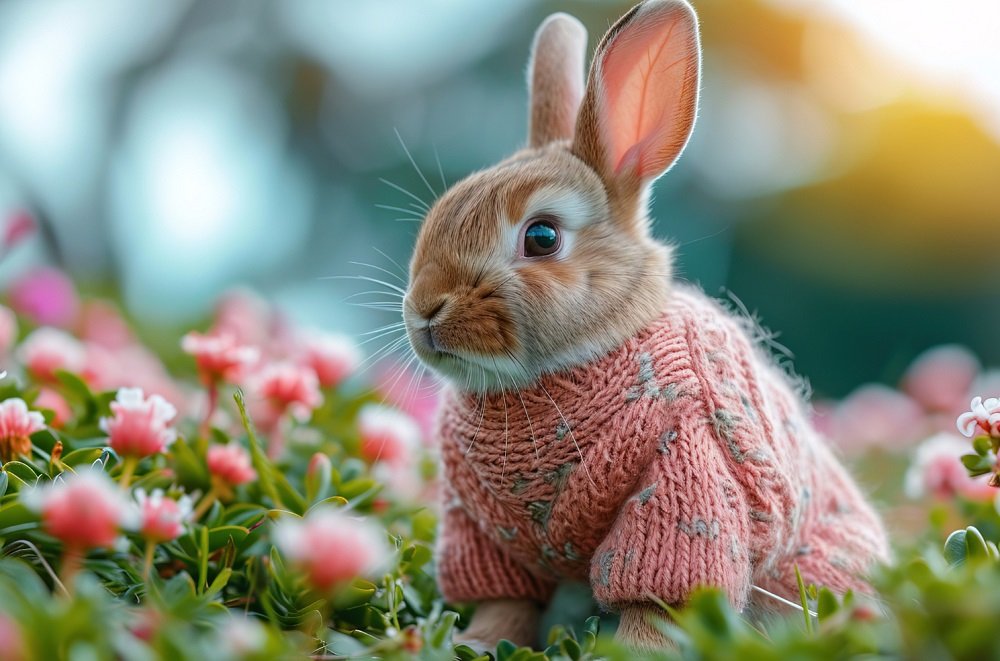Understanding how rabbits reproduce is crucial for responsible rabbit ownership. Knowing the intricacies of their gestation period, birth process, and newborn care can help ensure the health and well-being of both mother rabbit and her offspring.
The Rabbit Birth Process
Rabbits, like many mammals, give birth to live young. However, their reproductive cycle and birthing process have some unique characteristics that set them apart from other animals.
Gestation Period
A Quick Turnaround
The gestation period for rabbits is relatively short, typically lasting around 31 days. This means that a doe (female rabbit) can have multiple litters per year, depending on factors like breed, health, and environmental conditions.
How Are Rabbits Born?
Rabbits, those adorable and fluffy creatures, have a fascinating reproductive process. From conception to birth, there’s a lot happening behind the scenes. Let’s delve into the intricate world of rabbit birth and explore the stages involved.
The Journey Begins: Conception and Gestation
The rabbit reproductive cycle is unique and efficient. Unlike many mammals, rabbits don’t have a regular menstrual cycle. Instead, they are induced ovulators, meaning ovulation occurs only after mating. When a female rabbit, known as a doe, mates with a male rabbit, called a buck, sperm fertilizes the egg in her fallopian tubes. This marks the beginning of the gestation period.
Gestation Period
The gestation period for rabbits is surprisingly short, typically lasting around 31 days. This means that a doe can have multiple litters per year. During gestation, the developing embryos implant in the doe’s uterus and begin to grow rapidly. The doe’s body undergoes significant changes to support the growing offspring. (See Also: Why Is My Rabbits Nose Wet)
Preparing for Birth: Labor and Delivery
As the due date approaches, the doe will exhibit signs that labor is imminent. These signs may include:
- Loss of appetite
- Nesting behavior, such as gathering soft materials to create a comfortable birth space
- Restlessness and pacing
- Swollen abdomen
Labor itself can be a relatively quick process, lasting anywhere from a few hours to a full day. The doe will typically give birth to a litter of 4 to 12 kits, although the number can vary depending on the breed and individual doe. The kits are born blind, deaf, and hairless. They are completely dependent on their mother for warmth, nourishment, and protection.
Stages of Labor
Rabbit labor can be divided into three stages:
- Dilation: The cervix begins to dilate, allowing the kits to pass through the birth canal.
- Expulsion: The doe pushes to deliver the kits one by one.
- Placental expulsion: The placenta is expelled from the uterus.
Post-Birth Care: Nursing and Development
After birth, the doe will immediately begin to lick and clean her kits. This helps to stimulate their breathing and circulation. The doe’s milk is rich in nutrients and antibodies, providing the kits with essential nourishment for their rapid growth and development. Kits will nurse for several weeks, gradually weaning as they grow older.
Kit Development
Rabbit kits undergo rapid development in the first few weeks of life:
- Eyes open: Around 10-14 days old
- Ears open: Around 10-14 days old
- Fur develops: Gradually over the first few weeks
- Begin to explore their surroundings: Around 3-4 weeks old
- Weaning: Around 4-6 weeks old
Conclusion
The birth of rabbit kits is a remarkable process, showcasing the intricate workings of nature. From conception to weaning, the doe plays a vital role in ensuring the survival and well-being of her offspring. Understanding the stages of rabbit birth and the care required for newborn kits is essential for responsible rabbit ownership. (See Also: Do Rabbits Like The Rain)
In summary, we’ve explored the fascinating journey of rabbit birth, covering the following key points:
- Induced ovulation and the short gestation period of approximately 31 days
- Signs of labor and the three stages of labor: dilation, expulsion, and placental expulsion
- The crucial role of the doe in licking and cleaning kits, stimulating their breathing and circulation
- The rapid development of kits, including the opening of eyes and ears, fur development, exploration, and weaning
By appreciating the complexities of rabbit reproduction, we can better understand and care for these delightful creatures.
Frequently Asked Questions About Rabbit Births
How long is a rabbit’s gestation period?
A rabbit’s gestation period, also known as pregnancy, typically lasts about 31 days. However, it can vary slightly depending on the breed and individual rabbit.
How many babies do rabbits usually have?
Rabbits are known for having large litters. A typical litter size ranges from 4 to 12 kits, but some breeds can have up to 14 or more.
Where do rabbits give birth?
Rabbits instinctively seek out a safe and secluded place to give birth. They often choose a nest box, a quiet corner of their cage, or a burrow in the ground. The nest is typically lined with soft materials like hay, fur, or shredded paper. (See Also: How Often To Rabbits Breed)
Are rabbit kits born blind and deaf?
Yes, rabbit kits are born blind and deaf. They rely on their sense of smell and touch to navigate and find their mother’s milk. Their eyes and ears open gradually over the next few weeks.
How long do rabbit kits stay with their mother?
Rabbit kits typically stay with their mother for about 4 to 6 weeks. During this time, they nurse, learn essential skills, and gradually become more independent.


